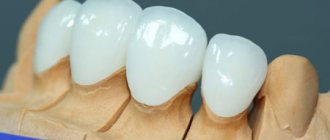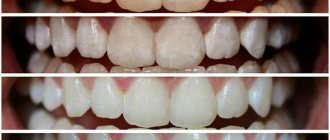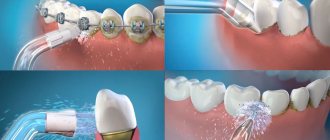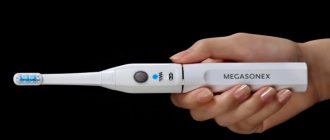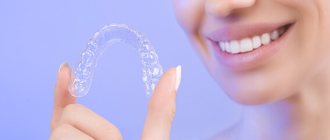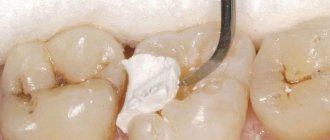The author of the article is dental hygienist A. V. Makarova.
Among patients, there is an opinion that the whitening procedure is harmful and damages tooth enamel.
It's a delusion. The ZOOM-4 whitening procedure has been tested on thousands of patients and confirmed by many years of experience of our doctors. The system does not violate the integrity of tooth enamel. It discolors the pigments found in the tissues of the teeth.
There is also a myth that “the original color returns quickly.” This is not true: if there are no severe hormonal disorders in the human body (for example, diabetes), then the final color is stable for 3-5 years. In this case, it is necessary to follow the recommendations given by the doctor in the first days (7-10 days) after bleaching.
Advantages and disadvantages of the procedure
Positive sides:
- Quick results. In a single visit, you can noticeably lighten the enamel by several tones, the effect depends on its condition.
- No medical indications. The client of the dental clinic decides for himself whether he needs to whiten his teeth.
- Many methods with different effects and prices.
- No pain or other discomfort.
- Almost all methods are universal, which means they can be used for patients of different ages.
- There is no need to go through a recovery period.
- Getting rid of complexes and awkwardness when communicating with others.
The technique also has negative aspects:
- The most effective methods have a high cost.
- The effect does not last long. The smile will remain snow-white for 5-7 years, but no more.
- Increased sensitivity of enamel, its thinning. Pain may occur while eating if the food or water is too cold or too hot.
- Inability to change the color of filling material, implants, artificial crowns.
- The risk of losing the natural shade of teeth and excessive whiteness increases.
- The need to adhere to dietary nutrition to maintain results. It is not recommended to drink coffee, strong black tea, or eat foods with a high concentration of bright natural pigment.
You shouldn’t expect “Hollywood” white enamel from turmeric
Using any folk method, you must be clearly aware of this fact. Turmeric in this case is no exception. It will be able to lighten the enamel a little, returning it to its natural or natural shade. But even then, only if your teeth are not too neglected. If there is a large layer of plaque and hard deposits on them, and you are a coffee and cigarette lover, then the product will not be able to significantly affect the shade of the enamel - here you need the help of a qualified dentist, professional oral hygiene, and in-office whitening techniques. The product will not help improve the aesthetics of a smile even with non-carious problems, for example, with a wedge-shaped defect or enamel fluorosis.
Contraindications to teeth whitening
Doctors recommend completely abandoning the procedure or postponing it indefinitely during pregnancy and breastfeeding, as well as when:
- individual intolerance to the components of the whitening composition;
- the presence of a milk bite that has not changed to a permanent one;
- oncology;
- increased sensitivity of enamel;
- tissue damage due to traumatic exposure or other reasons;
- pulpitis in chronic form;
- orthodontic treatment;
- dental diseases (for example, caries) in the acute phase;
- a large number of fillings, fixed dentures, artificial crowns (possible color balance disturbances, unnatural whiteness of certain areas).
Each case is reviewed by a dentist; the doctor may prohibit lightening of the teeth to avoid adverse reactions. Why do you need teeth whitening if it will lead to irreversible consequences? It is likely that the presence of the above circumstances is not an absolute obstacle to a cosmetic procedure, and in the absence of dangerous risks it can be completed.
If you add natural oils to turmeric, its properties will increase
Turmeric and coconut oil go well together for teeth whitening. You can also dilute the powder of this useful plant to a thick paste using olive or sunflower oils, tea tree oil. Just add a few drops to it instead of water and brush your teeth as usual. Natural oils will make the procedure even more beneficial; they will nourish the gums, kill bacteria, and have an anti-inflammatory effect.
Natural oils enhance the properties of turmeric
How to reduce harmful effects
A dazzling smile does not mean that your teeth are completely healthy. Behind the thin enamel is dentin. It is a structure with yellowish or grayish pigmentation. Whitening uses active chemical compounds that lead to thinning of the enamel layer or damage to its integrity. This also affects the condition of the oral cavity.
To minimize negative consequences, the dentist performs the following actions:
- Conducts a visual inspection and assessment of the condition of hard and soft tissues in the mouth.
- Identifies possible contraindications.
- Selects a safe and effective method of teeth whitening.
- Uses any available methods to diagnose and relieve pathological processes.
Turmeric can be replaced with curry
The homeland of natural turmeric is India. There, the root or powder of this variety of plant from the ginger family has been used for more than 2.5 thousand years. The main areas of use are cooking and Ayurveda medicine. Also, turmeric is always included in spices such as curry. That is why you can use curry instead of turmeric to whiten teeth, but only if you are sure that the spice contains a natural product and not a substitute. Unfortunately, in Russia this situation occurs quite often.
Turmeric can be replaced with curry
How can you check the naturalness of a product? When rubbed on your fingers, fresh turmeric will release a very bright spicy aroma, and if the smell is very weak or absent, then this composition is unlikely to bring tangible benefits.
How to keep your teeth white longer
Depending on the technique used, the effect of professional whitening can last for more than one year. However, some patients return to the clinic after a few months for a repeat procedure. To ensure that your smile remains dazzling for a long time, doctors recommend adhering to the following rules:
- do not eat for 3 hours after teeth whitening, you can only drink clean water, then you must adhere to a special diet;
- Do not use a brush with hard bristles, as this will only increase sensitivity;
- purchase a paste without abrasive particles;
- rinse your mouth, use dental floss, and irrigator after each meal;
- Mouth rinses should not contain chlorhexidine (it stains teeth);
- follow a schedule of visits to the dentist for preventive examinations (at least once every six months);
- complete smoking cessation for 2-3 days, preferably for several weeks.
Special diet
To maintain the effect for a long time immediately after the procedure, you must adhere to a special diet. It is important to minimize the consumption of foods with bright colors. It is advisable to eat:
- porridge;
- dairy (but not fermented milk) products;
- fish and seafood;
- chicken, rabbit;
- egg white;
- white fruits and vegetables (such as bananas).
Along with eliminating food containing dyes from the diet, it is recommended to avoid coloring spices. This is turmeric, paprika. Dentists also do not advise eating smoked meats, citrus fruits, any berries, drinking coffee, black tea and alcoholic beverages.
Turmeric can cause allergies
We do not recommend using it if you are sensitive to various allergens, because simply the product can cause irritation of the oral mucosa, and its spicy smell can provoke the development of allergic rhinitis, lacrimation and even Quincke's edema. To avoid this, first test the effect of the paste diluted to clean your teeth on your wrist, leave it on for about ten minutes and remove thoroughly. If no negative reactions occur within 24 hours, then you can experiment further, but with caution!
Turmeric can cause allergies
Types of teeth whitening: pros and cons
There are no ideal lightening methods. Each has positive and negative sides that the patient must be prepared for. This is why you need to consult your dentist first.
Mouthguards
These are removable devices that are made of special materials that are not subject to oxidative processes. As a rule, structures are used to correct bites and change the position of teeth. If the mouth guard is installed correctly, it does not cause discomfort (pain or other discomfort). After the adaptation period, the patient completely forgets about the presence of a foreign object in the mouth.
The device is created from an impression, which the dentist first makes during the initial appointment. The finished structure is filled with a whitening agent and placed on the upper or lower jaw.
Advantages:
- low cost compared to other methods;
- Possibility of teeth whitening at home.
Flaws:
- insufficient visual effect, mouth guards will not get rid of intense yellowish deposits;
- risk of developing an allergic reaction;
- The method is contraindicated for persons with orthodontic structures in the mouth (plates, braces, etc.).
Laser technique
This method is one of the most effective. You can walk with a snow-white smile for up to 10 years, of course, if you do not ignore medical instructions. In this case, the enamel becomes white in just one session.
A gel composition is applied to the teeth, after which its components are activated using a laser, oxygen ions are formed, which penetrate the enamel layer and deactivate the coloring pigment.
Pros:
- To lighten by more than 5 tones, one visit to the clinic is enough;
- absence of pain and other discomfort;
- the device operates for a short time (about 20 minutes);
- the gel used has antiseptic properties and prevents inflammatory processes in the mouth;
- the components of the drug strengthen the enamel and protect it from external influences.
Negative sides:
- high price compared to alternative methods;
- increased tooth sensitivity immediately after the procedure.
Ultrasonic cleaning
In this case, enamel lightening occurs due to the removal of hard plaque and other deposits, even in the interdental spaces. With the help of vibrations, all layers are mechanically removed. After all the manipulations, the specialist applies a special paste-like composition to the teeth to improve the protection of the dentition from external influences and various chemical irritants.
Ultrasound helps to get rid of even subgingival plaque. The stone is also removed.
Pros:
- in one visit to the dentist you can lighten your teeth several shades;
- during the procedure, the entire oral cavity is cleaned, and not just hard tissues;
- absence of pain and other unpleasant sensations;
- affordable price.
Minuses:
- To consolidate the effect, ultrasonic cleaning should be repeated annually;
- the result may seem insufficient if the enamel is too dark;
- the natural shade of dentin tissue does not change;
- A visit to the doctor takes up to an hour.
Chemical bleaching
The dentist applies highly concentrated preparations that contain hydrogen peroxide or other active ingredients. As a result, dentin is whitened, its shade becomes lighter by 5-7 tones or more.
Advantages of the method:
- an effective procedure that removes plaque and lightens the dentinal layer;
- if all manipulations were performed according to the rules, the result can last up to 4-5 years.
Minuses:
- increased sensitivity of enamel after lightening;
- high price;
- the risk of burns to the mucous membranes if the dosage regimen of the chemical composition is not followed;
- It takes many procedures (about 7) at intervals of 2-3 days to achieve the desired effect.
Air Flow
The surface of the teeth is processed mechanically, without affecting the dentinal layer. The doctor uses a sandblasting machine for this. Even the most difficult to reach areas (for example, interdental spaces) will be clean after exposure to a mixture of water, air and soda. The enamel is polished and the smile becomes dazzling.
Advantages:
- absence of pain and other discomfort;
- the entire oral cavity is cleansed, including the space between the teeth, under the gums, etc.;
- fabrics are not damaged, abrasive particles act very gently;
- the patient is not bothered by increased tooth sensitivity immediately after brushing;
- affordable price.
Minuses:
- insufficiently expressed visual effect;
- a greater number of contraindications compared to alternative methods;
- the color lasts up to a year.
Photobleaching
One of the most modern techniques with ZOOM or Luma-Arch devices. The enamel brightens due to ultraviolet exposure. The lamp warms up the lightening gel applied to the teeth, thereby enhancing its effect.
Pros:
- the procedure lasts about 15 minutes;
- per visit you can make the enamel 10 shades lighter;
- the effect lasts up to 4 years if you follow the rules established by your doctor and adhere to basic hygiene standards;
- absence of pain syndrome.
Minuses:
- high cost (methods involving mechanical cleansing will be much cheaper);
- It is advisable to completely exclude foods with bright dyes from the diet;
- subsequent remineralization may be required;
- before photobleaching, it is necessary to remove microprostheses and veneers;
- bleaching is uneven, hard-to-reach areas are not lightened, but only the front incisors and canines;
- If the procedure technique is not followed, the risk of burns to the mucous membranes of the oral cavity increases.
Endobleaching
This technique is also called in-canal bleaching. This method is used when depulpation has been performed, that is, removal of palpable tissue. After the death of the nerve, the teeth darken, so many patients want to lighten them.
The doctor pours a special synthetic composition with a whitening effect into the cavity and places a temporary filling material on top. If the enamel becomes lighter within 10-15 days, the drug is removed and everything is filled.
Advantages:
- you can lighten one or several teeth at once;
- the enamel remains intact because the whitening agent acts from the inside.
Flaws:
- short-term effect (up to a year);
- not suitable for processing both rows;
- the price increases as the number of teeth treated increases.
Home whitening
Not all patients want to visit a dental clinic and prefer to whiten their enamel at home. The most common procedures:
- The use of special whitening pastes. Typically, such compositions contain abrasives, affecting the entire surface of the dentition. As a result, it is possible to lighten the enamel layer by several tones.
- Special stripes. They resemble a plaster and are glued to the incisors of the upper and lower jaws. The adhesive side contains a gel with concentrated chemical compounds. An oxidation process takes place in the mouth, which promotes quick and easy cleansing.
- Traditional methods. Fans of “grandmother’s” recipes use hydrogen peroxide, soda, activated carbon and other substances.
What are the advantages of self-lightening at home:
- low price;
- ease of implementation.
The list of disadvantages is much more extensive than the list of advantages. This:
- low effectiveness compared to professional care;
- negative impact on enamel, damage to the mucous membranes of the oral cavity, the appearance of hypersensitivity to any irritant;
- high risk of allergies and poisoning due to careless use and, as a result, ingestion of bleaching mixtures.
Consequences of smoking
From the first months of smoking, tobacco gradually changes the composition of saliva, dulls the functioning of receptors, and also:
- May cause chronic gum inflammation and soreness.
- Promotes bleeding of oral tissues.
- Gradually destroys the integrity of tooth enamel.
- Can lead to stomatitis, the appearance of ulcers on the cheeks, gums, and tongue.
- Causes an unpleasant odor in the human mouth.
Tobacco smoke also negatively affects the healing process of oral tissues. In this regard, people who smoke have a harder time with dental procedures: fillings fall out more often, and after tooth extraction, the hole will take longer to heal.
Is teeth whitening worth it?
This is a very responsible procedure; if you make mistakes, you can start irreversible pathological processes. Doctors recommend dental cleanings twice a year to remove accumulated plaque. This is a superficial method that does not lighten the dentition. If a patient wants to whiten his teeth, he is indicated for professional whitening in dentistry.
Doctors do not recommend performing the procedure at home with store-bought pharmaceutical formulations. Firstly, it is very difficult to correctly calculate the dosage that will be safe for the enamel and for the entire body if accidentally swallowed. Secondly, even one careless action can lead to burns of the mucous membranes.
After lightening the enamel, you need to be prepared for sensitivity to temperature changes, sour, sweet, and solid foods. In addition, careful hygiene and diet will be required, which not everyone is ready for.
Having studied the indications and contraindications for professional cosmetic teeth whitening, the pros and cons of the procedure, you can choose a technique that is right for you. We invite you to sign up for a preliminary consultation with a Dentiki dentist by calling the number listed on the website or filling out the feedback form.
Comments
I am now two months pregnant, can I try brushing my teeth with turmeric, will it cause any harm?
Tatyana (03/31/2019 at 12:25) Reply to comment
- Dear Tatyana! It is not advisable to use turmeric for women who are pregnant or breastfeeding. In particular, this restriction applies to those who use it internally for medicinal purposes, but when cleaning your teeth, the product can enter the stomach through the mouth or you can swallow a little of the composition - this is not dangerous, but it is worth remembering that turmeric can cause uterine contractions, as well as provoke the development of allergies and diathesis in the child.
Editorial staff of the portal UltraSmile.ru (04/04/2019 at 09:07) Reply to comment
Good afternoon. If you have several metal-ceramic crowns on your front teeth, you can whiten your living teeth with turmeric. Will turmeric stain metal-ceramic crowns? After all, it is written that it leaves stains even on the sink, etc.
Marina (05/18/2019 at 00:30) Reply to comment
Write your comment Cancel reply
Reviews
Below are some reviews. If you have something to say, leave your feedback in the comments below the article, it will be useful to our readers.
Anastasia, 34 years old
My first acquaintance with coconut oil happened a couple of years ago, and from then on I fell in love with it. I use it in hair and skin care. But I recently found out that it is used to whiten teeth, and I was surprised. At first I didn’t believe it, but I checked anyway. I was pleased with the result. Now I brush my teeth with coconut oil more often than with regular toothpaste. Sometimes I add turmeric.
Svetlana, 25 years old
I have tried many ways to whiten my teeth. But nothing really helped. As a result, I found out that you can lighten your teeth with turmeric and coconut oil. I checked and was convinced of this. But you need to use it regularly. Now I recommend this recipe to everyone I know.
Some of my favorite toothpaste recipes today:
Teeth whitening with activated carbon
DIY toothpaste and the benefits of saliva
How to make toothpaste from baking soda
Oil pulling for dental health
DIY reminiscing toothpaste
The other one I'm going to tell you about today is turmeric, a gorgeous yellow spice that is often used to give mustard its vibrant color. While these two substances are known for staining just about everything else, they actually remove stains from teeth and lighten the overall color of teeth.
I wrote a little about how activated charcoal works in my ebook, but the mechanism behind turmeric is still a mystery. Here's what you need to know:
Efficiency of application
Turmeric is used in many recipes to improve the health of the body. It is rich in vitamins and contains curcumin, which is a natural antioxidant. The spice also has bactericidal and anti-inflammatory properties. It copes well with oral problems, such as gum inflammation, bleeding, and also heals small wounds.
The bright yellow color of the spice and the fact that it is a natural food coloring raises doubts about its whitening properties. But, paradoxically, turmeric does an excellent job of brightening enamel.
When used daily, the spice fights plaque, which causes a yellow tint to the enamel. Thanks to this effect, you can whiten teeth with turmeric to their natural color by one to three shades, depending on the initial state.
